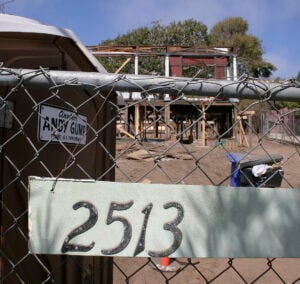
CITYWIDE — In 2011, a house on the 2500 block of Third Street lost its lid. And somewhere close to 49 percent of its walls.
The single-family residence, built in 1895, exemplified "turn of the 20th century"-style architecture, one of five in a row of homes built around the same time that appear on the City Hall Historic Resources Inventory, a document of over 1,000 buildings in Santa Monica of varying degrees of historic significance.
No longer.
The architect in charge of remodeling the home stripped the old building down to its skivvies, baring the studs that form the basis of the home's structure and removing all of the exterior elements that indicated its age and architecture.
Members of the historic preservation community protested the loss, but to no avail — a clever reading of the zoning code allowed the architect to skirt a hearing before the Landmarks Commission that might have preserved the exterior of the home.
That provision is called "substantial remodel," and states that a remodel rises to the level of a demolition when 50 percent or more of the exterior walls are removed, a definition which does not include the plaster or other defining features of those walls that are so prized by preservationists.
It's one of the many aspects of Santa Monica's zoning code that's getting a look-over as the Planning Department and its consultants from Dyett & Bhatia Urban & Regional Planners, a San Francisco-based planning firm, embark on an update they expect to finish by 2013.
The zoning code is the flesh that hangs on the skeleton defined by the Santa Monica community in the Land Use and Circulation Element, a tome of a document meant to provide guidance on development, circulation and other critical elements of Santa Monica.
Whereas the LUCE provided the outline and form, the zoning code fills in the details of policies, providing the "how" to go along with the LUCE's dictates.
It is, therefore, long, complicated and often tedious to the layperson, but it governs aspects of how the city looks and moves that many people care about, and it hasn't seen an update since 1988.
"[T]here have been many significant changes in the way we live, work and play since that time, and the Zoning Ordinance needs to be updated to reflect those changes," wrote planners on a website dedicated to the zoning update.
In some cases, like the substantial remodel definition, the language of the old zoning code has created unintended consequences.
It's meant to prevent homeowners from effectively demolishing their homes without the appropriate permits in the name of "remodel," said Planning Director David Martin.
That could be preferable to homeowners to avoid the trouble of getting a permit, and also because some homes have aspects — like inadequate parking or setbacks — that would no longer be allowed under the municipal playbook.
Skirting the review process by avoiding the need to pull a permit for demolition or substantial remodel would save them the headache. If the building is 40 years old or older, it also means they don't have to visit the Landmarks Commission for a review of the house's potential historic nature.
That end run around the process is one of two things that led to the stripping of the home on Third Street, and it's an outcome that preservationists have been trying to overcome since 2004, said Nina Fresco, a Landmarks commissioner.
"It came up in the work plan to look at that definition because people were abusing it back then," she said.
Commissioners at the time were advocating for "skins" of buildings to be included in the calculations, meaning that leaving the bare wooden supports would not be enough to constitute the preservation of a wall.
"You can't remove the siding and change all of the windows and not trigger a substantial remodel," Fresco said.
While the Planning Department and its consultants recognize that the definition has been used creatively, it must step cautiously to balance the desires of the preservation community with that of homeowners, said Jory Phillips, a city planner brought on in mid-2011 specifically to deal with the zoning code update.
"We do want the average homeowner to be able to remodel their home without too much trouble," Phillips said.
The goal is to create a definition that speaks more to the character of the building and less to the structural members that remain underneath the surface and also retains enough subjectivity to make sure "good things" don't get held up in the bureaucratic process.
So far, neither the department nor its consultant from Dyett & Bhatia, Vivian Kahn, have decided how to accomplish that.
Many areas don't require even this level of review unless the structure is already designated a landmark, while others, like San Francisco, require almost everything to come before a deciding body, Kahn said.
"One of the issues that jurisdictions are constantly grappling with is how much of a burden to impose on homeowners," she said.
In Pasadena, a city with a large number of historic homes and buildings, planners have a separate definition of demolition that speaks directly to historic preservation.
A structural wall that faces the street cannot be changed in such a way that has "an adverse effect" on the significance of the property without review, said Kevin Johnson, a planner in the city.
"In Pasadena, most of the people here are knowledgable of or embrace historic preservation," Johnson said. "In most cases, it's not an issue."
If Santa Monica's new definition means throwing the breaks on de facto demolitions long enough for the commission to review them, it's done its job, Fresco said.
"We want to protect those until we can research them properly," Fresco said.
ashley@www.smdp.com








